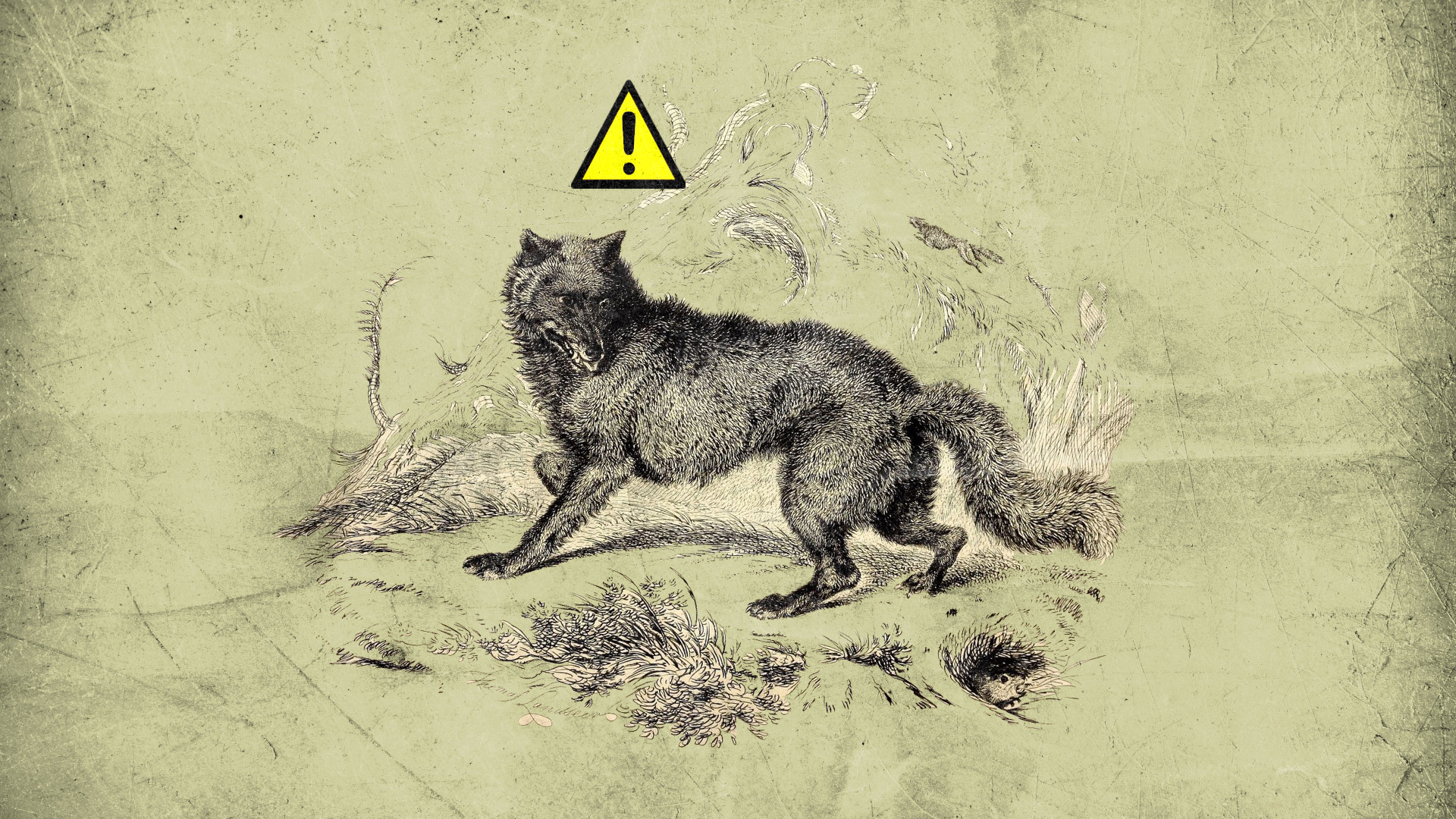
A biological illustration from the 1820s depicts an American gray wolf. Wolves were seen as menacing creatures and subjected to persecution, largely by white settlers, prior to the Endangered Species Act of 1973. (Graphic by OPB.)
Bradley W. Parks / OPB
Gray wolves have had protection under the Endangered Species Act almost as long as there’s been an Endangered Species Act. Now, the wolves are walking in the world without the federal government’s protective shields they once wore.
The Trump administration announced in October that it would remove all remaining Endangered Species Act protections for gray wolves in the lower 48 states, a move that had been in the works since March 2019. The decision exempts experimental packs of Mexican gray wolves living in Arizona and New Mexico.
When that decision took effect Monday, it formally shifted conservation and management of gray wolves entirely to state and tribal governments.
“At this point, I would not expect major changes,” said Michelle Dennehy, a spokesperson for the Oregon Department of Fish and Wildlife. “It’s kind of business as usual for wolf management in Oregon.”
The question is whether business as usual can aid in the continued recovery of gray wolves in Oregon while also keeping the livestock industry happy. Before Monday, Oregon’s gray wolves were federally protected in the western two-thirds of the state. (Those in the easternmost third lost protection in 2011.)
History of hostility
The Trump administration hailed delisting as a symbol of gray wolves’ remarkable comeback. Conservation groups have challenged the decision in court, calling it premature.
The U.S. gray wolf population has steadily climbed in the past half-century, but they still occupy only a fraction of their historical range. Gray wolves have a tenuous grip on stability, which is true in Oregon as well.
“Across Oregon, there’s just a huge gap in the species’ presence,” said Danielle Moser, wildlife program director for Oregon Wild.
The most recent count shows 158 gray wolves in Oregon as of 2019. The majority of them live in the northeast corner of the state, having come over from Idaho. The number is a drastic improvement from the 14 gray wolves counted statewide a decade earlier, but research suggests Oregon could support about 10 times its current gray wolf population.
Humans have proven hostile to gray wolves throughout history. Livestock depredation led white settlers to wage war on the keystone species for hundreds of years. Wolves were the target of colonial and, later on, territorial and state bounties.
“Wolves have quite a sordid history in this country,” Moser said. “Wolves were hunted, they were extirpated, they were poisoned, everything you can think of. They were trapped pretty much out of existence.”
Related: When have gray wolves actually recovered?
Apex predators like gray wolves are critically important to ecological health. They help control the population of other mammals like deer and elk, which in turn helps many plant species, so on and so forth.
As OPB reported in 2015, wolves can live just about anywhere and eat just about anything. The upward population trend of the past several years can continue pretty easily in theory.
The only thing standing in the way is us.
Canis lupus versus cattle
Gray wolves lost state-level endangered-species status in 2015, but they still have some protections under the Oregon Wolf Conservation and Management Plan. Hunting and trapping of gray wolves remains banned statewide.
However, the removal of federal Endangered Species Act protections opens up gray wolves in Western Oregon to “lethal control” — a euphemism for being killed by government agents — in cases of chronic depredation. In other words, if a wolf eats too much livestock, time’s up for said wolf.
Rodger Huffman is a La Grande-area rancher who co-chairs the Oregon Cattlemen’s Association wolf task force.
“In the case of cattle versus wolf, cattle are gonna lose every time,” Huffman said.
Oregon does not require landowners to use non-lethal methods for deterring wolves such as fencing or flagging. Dennehy, with the Department of Fish and Wildlife, said the state will not kill wolves unless non-lethal measures prove unsuccessful.
More gray wolves does not necessarily translate to more conflict with livestock. The growth rate of the gray wolf population has far outpaced any increase in the rate of confirmed livestock depredation incidents in Oregon.
Huffman said having the option for lethal control, however, helps livestock producers and operators defend their businesses from “chronic offenders.”
“We’re just asking for a little relief,” Huffman said. “We’re not unrealistic in thinking that we’re ever going to get total removal.”
Related: Researchers cast doubt on whether killing wolves actually works
The Department of Fish and Wildlife didn’t kill any wolves for depredation in 2019, the year of its most recent annual report. It has killed 16 wolves total since 2009.
Losing federal protections still carries a lot of heft. Moser said it’s unclear how the state conservation and management plan will work in the western half of Oregon where wolf packs are smaller and human population centers are larger.
“Quite frankly, in the past, it’s been questionable how ODFW would approach species management,” said Oregon Wild’s Moser, “and so I guess this is an opportunity for them to really prove to Oregonians that they really care about wolves.”

